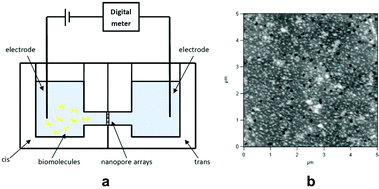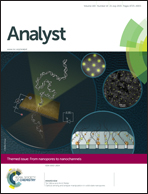Experimental and theoretical investigations on temperature modulated translocation of IgG molecules through nanopore arrays
Abstract
In the past few decades, nanopore based biosensing has attracted more and more attention. In this work, a novel fluidic sensor was fabricated using two separated liquid cells, which were linked by polycarbonate (PC) ultrafiltration membranes containing nanopore arrays. The trans-membrane ionic current generated by the applied voltage and the current changes modulated by a goat antibody to human immunoglobulin G (IgG) translocation were recorded simultaneously. The experimental results show that the ionic current is modulated by the physical place-holding effect generated by IgG translocation through nanopore arrays. For different temperatures (4 °C, 22 °C, and 45 °C) and different concentrations of the electrolyte (0.01 mol L−1, 0.10 mol L−1 and 1.0 mol L−1), the relative variance of the ionic current ((I0 − I)/I0) modulated by IgG translocation increases at first and then decreases and stabilizes. With the increase of the IgG concentration, there is an obvious “inflection point” corresponding to the maximum value of the relative variance of the ionic current. The concentration of the electrolyte does not affect the position of the “inflection point”, while temperature increment makes the “inflection point” shift to the high IgG concentration direction. Finally, a simplified model is suggested and the calculated results contribute to the understanding of the temperature induced IgG translocation behavior, which matches the ionic current changing tendency obtained in our experiments.

- This article is part of the themed collection: From nanopores to nanochannels

 Please wait while we load your content...
Please wait while we load your content...